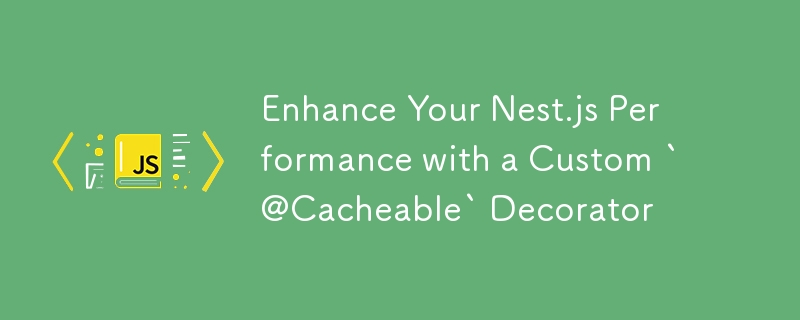使用自定义“@Cacheable”装饰器增强 Nest.js 性能
发布于2024-11-01

缓存是提高应用程序性能和可扩展性的基本技术。在 Nest.js 中,可以使用内置的缓存管理器无缝集成缓存。在本文中,我们将探讨如何创建自定义 @Cacheable 装饰器来简化 Nest.js 服务或控制器中的缓存。
?为什么使用自定义 @Cacheable 装饰器?
虽然 Nest.js 提供了强大的开箱即用的缓存机制,但直接在方法中应用缓存逻辑可能会使您的代码变得混乱。自定义装饰器抽象了此逻辑,使您的代码更干净且更易于维护。
?创建@Cacheable装饰器
让我们首先创建 @Cacheable 装饰器,我们将使用它来缓存方法的结果。
import { Cache } from 'cache-manager';
export function Cacheable(cacheKey: string) {
return function (
target: any,
propertyName: string,
descriptor: PropertyDescriptor,
) {
const originalMethod = descriptor.value;
descriptor.value = async function (...args: any[]) {
const cache: Cache = this.cacheManager;
if (!cache) {
throw new Error(
'Cannot use Cacheable() decorator without injecting the cache manager.',
);
}
// Try to get cached data
try {
const cachedResult = await cache.get(cacheKey);
if (cachedResult) {
return cachedResult;
}
} catch (error) {
console.error(`Cache get error for key: ${cacheKey}:`, error);
}
// Call the original method if cache miss
const result = await originalMethod.apply(this, args);
// Set the new result in cache
try {
await cache.set(cacheKey, result);
} catch (error) {
console.error(`Cache set error for key: ${cacheKey}:`, error);
}
return result;
};
return descriptor;
};
}
?解释
- 缓存检索:在执行原始方法之前,装饰器检查结果是否已经缓存。
- Cache Miss Handling:如果结果不在缓存中,则执行原方法,然后缓存结果。
- 错误处理:捕获并记录缓存检索或设置期间的任何错误,确保您的应用程序不会因缓存问题而崩溃。
?使用@Cacheable装饰器
以下是如何将 @Cacheable 装饰器应用到服务中的方法:
import { Injectable } from '@nestjs/common';
import { Cacheable } from './cacheable.decorator';
const SETTING_CACHE_KEY = 'settings';
@Injectable()
export class SettingsService {
// Inject the cache manager
constructor(private readonly cacheManager: Cache) {}
/**
* Retrieves settings from the cache if available, or loads them from the
* repository and caches the result.
*
* @returns A promise that resolves to a `Settings` object.
*/
@Cacheable(SETTING_CACHE_KEY)
async getSettings(): Promise {
return await this.findAll();
}
// ... other methods like findAll() and buildTree()
}
?解释
- 装饰器应用:@Cacheable装饰器应用到具有特定缓存键的getSettings()方法。
- 依赖注入:将缓存管理器注入到装饰器使用的服务中。
?在 Nest.js 中集成缓存管理器
要在应用程序中使用缓存管理器,您需要在模块中注册它:
import { Module } from '@nestjs/common';
import { CacheModule } from '@nestjs/cache-manager';
import { SettingsService } from './settings.service';
@Module({
imports: [
CacheModule.register({
isGlobal: true,
ttl: 300, // Time to live in seconds
max: 100, // Maximum number of items in cache
}),
],
providers: [SettingsService],
})
export class AppModule {}
?解释
- 全局缓存:设置 isGlobal: true 使缓存管理器在整个应用程序中可用。
- TTL 和最大项目数:配置缓存中的生存时间 (ttl) 和最大项目数 (max)。
?注入缓存管理器
确保将缓存管理器注入到使用 @Cacheable 装饰器的任何服务或控制器中:
import { Injectable } from '@nestjs/common';
import { Cache } from 'cache-manager';
@Injectable()
export class SettingsService {
constructor(private readonly cacheManager: Cache) {}
// ... your methods
}
?结论
通过创建自定义 @Cacheable 装饰器,您可以保持方法干净并专注于核心逻辑,将缓存问题留给装饰器。这种方法增强了代码的可读性和可维护性,使您的 Nest.js 应用程序更加高效和可扩展。
请随时在下面留下评论或问题。快乐编码! ?
版本声明
本文转载于:https://dev.to/marrouchi/enhance-your-nestjs-performance-with-a-custom-cacheable-decorator-589o?1如有侵犯,请联系[email protected]删除
最新教程
更多>
-
 版本5.6.5之前,使用current_timestamp与时间戳列的current_timestamp与时间戳列有什么限制?在时间戳列上使用current_timestamp或MySQL版本中的current_timestamp或在5.6.5 此限制源于遗留实现的关注,这些限制需要对当前的_timestamp功能进行特定的实现。 创建表`foo`( `Productid` int(10)unsigned not n...编程 发布于2025-03-15
版本5.6.5之前,使用current_timestamp与时间戳列的current_timestamp与时间戳列有什么限制?在时间戳列上使用current_timestamp或MySQL版本中的current_timestamp或在5.6.5 此限制源于遗留实现的关注,这些限制需要对当前的_timestamp功能进行特定的实现。 创建表`foo`( `Productid` int(10)unsigned not n...编程 发布于2025-03-15 -
 为什么尽管有效代码,为什么在PHP中捕获输入?在php ;?>" method="post">The intention is to capture the input from the text box and display it when the submit button is clicked.但是,输出...编程 发布于2025-03-15
为什么尽管有效代码,为什么在PHP中捕获输入?在php ;?>" method="post">The intention is to capture the input from the text box and display it when the submit button is clicked.但是,输出...编程 发布于2025-03-15 -
 如何为PostgreSQL中的每个唯一标识符有效地检索最后一行?postgresql:为每个唯一标识符在postgresql中提取最后一行,您可能需要遇到与数据集合中每个不同标识的信息相关的信息。考虑以下数据:[ 1 2014-02-01 kjkj 在数据集中的每个唯一ID中检索最后一行的信息,您可以在操作员上使用Postgres的有效效率: id dat...编程 发布于2025-03-15
如何为PostgreSQL中的每个唯一标识符有效地检索最后一行?postgresql:为每个唯一标识符在postgresql中提取最后一行,您可能需要遇到与数据集合中每个不同标识的信息相关的信息。考虑以下数据:[ 1 2014-02-01 kjkj 在数据集中的每个唯一ID中检索最后一行的信息,您可以在操作员上使用Postgres的有效效率: id dat...编程 发布于2025-03-15 -
 如何在Java字符串中有效替换多个子字符串?在java 中有效地替换多个substring,需要在需要替换一个字符串中的多个substring的情况下,很容易求助于重复应用字符串的刺激力量。 However, this can be inefficient for large strings or when working with nu...编程 发布于2025-03-15
如何在Java字符串中有效替换多个子字符串?在java 中有效地替换多个substring,需要在需要替换一个字符串中的多个substring的情况下,很容易求助于重复应用字符串的刺激力量。 However, this can be inefficient for large strings or when working with nu...编程 发布于2025-03-15 -
 为什么不使用CSS`content'属性显示图像?在Firefox extemers属性为某些图像很大,&& && && &&华倍华倍[华氏华倍华氏度]很少见,却是某些浏览属性很少,尤其是特定于Firefox的某些浏览器未能在使用内容属性引用时未能显示图像的情况。这可以在提供的CSS类中看到:。googlepic { 内容:url(&#...编程 发布于2025-03-15
为什么不使用CSS`content'属性显示图像?在Firefox extemers属性为某些图像很大,&& && && &&华倍华倍[华氏华倍华氏度]很少见,却是某些浏览属性很少,尤其是特定于Firefox的某些浏览器未能在使用内容属性引用时未能显示图像的情况。这可以在提供的CSS类中看到:。googlepic { 内容:url(&#...编程 发布于2025-03-15 -
 可以在纯CS中将多个粘性元素彼此堆叠在一起吗?[2这里: https://webthemez.com/demo/sticky-multi-header-scroll/index.html </main> <section> { display:grid; grid-template-...编程 发布于2025-03-15
可以在纯CS中将多个粘性元素彼此堆叠在一起吗?[2这里: https://webthemez.com/demo/sticky-multi-header-scroll/index.html </main> <section> { display:grid; grid-template-...编程 发布于2025-03-15 -
 PHP阵列键值异常:了解07和08的好奇情况PHP数组键值问题,使用07&08 在给定数月的数组中,键值07和08呈现令人困惑的行为时,就会出现一个不寻常的问题。运行print_r($月份)返回意外结果:键“ 07”丢失,而键“ 08”分配给了9月的值。此问题源于PHP对领先零的解释。当一个数字带有0(例如07或08)的前缀时,PHP将...编程 发布于2025-03-15
PHP阵列键值异常:了解07和08的好奇情况PHP数组键值问题,使用07&08 在给定数月的数组中,键值07和08呈现令人困惑的行为时,就会出现一个不寻常的问题。运行print_r($月份)返回意外结果:键“ 07”丢失,而键“ 08”分配给了9月的值。此问题源于PHP对领先零的解释。当一个数字带有0(例如07或08)的前缀时,PHP将...编程 发布于2025-03-15 -
 我可以将加密从McRypt迁移到OpenSSL,并使用OpenSSL迁移MCRYPT加密数据?将我的加密库从mcrypt升级到openssl 问题:是否可以将我的加密库从McRypt升级到OpenSSL?如果是这样,如何?答案:是的,可以将您的Encryption库从McRypt升级到OpenSSL。可以使用openssl。附加说明: [openssl_decrypt()函数要求iv参...编程 发布于2025-03-15
我可以将加密从McRypt迁移到OpenSSL,并使用OpenSSL迁移MCRYPT加密数据?将我的加密库从mcrypt升级到openssl 问题:是否可以将我的加密库从McRypt升级到OpenSSL?如果是这样,如何?答案:是的,可以将您的Encryption库从McRypt升级到OpenSSL。可以使用openssl。附加说明: [openssl_decrypt()函数要求iv参...编程 发布于2025-03-15 -
 Python读取CSV文件UnicodeDecodeError终极解决方法在试图使用已内置的CSV模块读取Python中时,CSV文件中的Unicode Decode Decode Decode Decode decode Error读取,您可能会遇到错误的错误:无法解码字节 在位置2-3中:截断\ uxxxxxxxx逃脱当CSV文件包含特殊字符或Unicode的路径逃...编程 发布于2025-03-15
Python读取CSV文件UnicodeDecodeError终极解决方法在试图使用已内置的CSV模块读取Python中时,CSV文件中的Unicode Decode Decode Decode Decode decode Error读取,您可能会遇到错误的错误:无法解码字节 在位置2-3中:截断\ uxxxxxxxx逃脱当CSV文件包含特殊字符或Unicode的路径逃...编程 发布于2025-03-15 -
 如何使用不同数量列的联合数据库表?合并列数不同的表 当尝试合并列数不同的数据库表时,可能会遇到挑战。一种直接的方法是在列数较少的表中,为缺失的列追加空值。 例如,考虑两个表,表 A 和表 B,其中表 A 的列数多于表 B。为了合并这些表,同时处理表 B 中缺失的列,请按照以下步骤操作: 确定表 B 中缺失的列,并将它们添加到表的末...编程 发布于2025-03-15
如何使用不同数量列的联合数据库表?合并列数不同的表 当尝试合并列数不同的数据库表时,可能会遇到挑战。一种直接的方法是在列数较少的表中,为缺失的列追加空值。 例如,考虑两个表,表 A 和表 B,其中表 A 的列数多于表 B。为了合并这些表,同时处理表 B 中缺失的列,请按照以下步骤操作: 确定表 B 中缺失的列,并将它们添加到表的末...编程 发布于2025-03-15 -
 如何在JavaScript对象中动态设置键?在尝试为JavaScript对象创建动态键时,如何使用此Syntax jsObj['key' i] = 'example' 1;不工作。正确的方法采用方括号: jsobj ['key''i] ='example'1; 在JavaScript中,数组是一...编程 发布于2025-03-15
如何在JavaScript对象中动态设置键?在尝试为JavaScript对象创建动态键时,如何使用此Syntax jsObj['key' i] = 'example' 1;不工作。正确的方法采用方括号: jsobj ['key''i] ='example'1; 在JavaScript中,数组是一...编程 发布于2025-03-15 -
 如何使用FormData()处理多个文件上传?)处理多个文件输入时,通常需要处理多个文件上传时,通常是必要的。 The fd.append("fileToUpload[]", files[x]); method can be used for this purpose, allowing you to send multi...编程 发布于2025-03-15
如何使用FormData()处理多个文件上传?)处理多个文件输入时,通常需要处理多个文件上传时,通常是必要的。 The fd.append("fileToUpload[]", files[x]); method can be used for this purpose, allowing you to send multi...编程 发布于2025-03-15 -
 \“(1)vs.(;;):编译器优化是否消除了性能差异?\”答案: 在大多数现代编译器中,while(1)和(1)和(;;)之间没有性能差异。编译器: perl: 1 输入 - > 2 2 NextState(Main 2 -E:1)V-> 3 9 Leaveloop VK/2-> A 3 toterloop(next-> 8 last-> 9 ...编程 发布于2025-03-15
\“(1)vs.(;;):编译器优化是否消除了性能差异?\”答案: 在大多数现代编译器中,while(1)和(1)和(;;)之间没有性能差异。编译器: perl: 1 输入 - > 2 2 NextState(Main 2 -E:1)V-> 3 9 Leaveloop VK/2-> A 3 toterloop(next-> 8 last-> 9 ...编程 发布于2025-03-15 -
 如何克服PHP的功能重新定义限制?克服PHP的函数重新定义限制 但是,PHP工具腰带中有一个隐藏的宝石:runkit扩展。它使您能够灵活地重新定义函数。 runkit_function_renction_rename() runkit_function_redefine() //重新定义'this'以返回“新和改...编程 发布于2025-03-15
如何克服PHP的功能重新定义限制?克服PHP的函数重新定义限制 但是,PHP工具腰带中有一个隐藏的宝石:runkit扩展。它使您能够灵活地重新定义函数。 runkit_function_renction_rename() runkit_function_redefine() //重新定义'this'以返回“新和改...编程 发布于2025-03-15 -
 如何修复\“常规错误:2006 MySQL Server在插入数据时已经消失\”?How to Resolve "General error: 2006 MySQL server has gone away" While Inserting RecordsIntroduction:Inserting data into a MySQL database can...编程 发布于2025-03-15
如何修复\“常规错误:2006 MySQL Server在插入数据时已经消失\”?How to Resolve "General error: 2006 MySQL server has gone away" While Inserting RecordsIntroduction:Inserting data into a MySQL database can...编程 发布于2025-03-15
学习中文
- 1 走路用中文怎么说?走路中文发音,走路中文学习
- 2 坐飞机用中文怎么说?坐飞机中文发音,坐飞机中文学习
- 3 坐火车用中文怎么说?坐火车中文发音,坐火车中文学习
- 4 坐车用中文怎么说?坐车中文发音,坐车中文学习
- 5 开车用中文怎么说?开车中文发音,开车中文学习
- 6 游泳用中文怎么说?游泳中文发音,游泳中文学习
- 7 骑自行车用中文怎么说?骑自行车中文发音,骑自行车中文学习
- 8 你好用中文怎么说?你好中文发音,你好中文学习
- 9 谢谢用中文怎么说?谢谢中文发音,谢谢中文学习
- 10 How to say goodbye in Chinese? 再见Chinese pronunciation, 再见Chinese learning

























